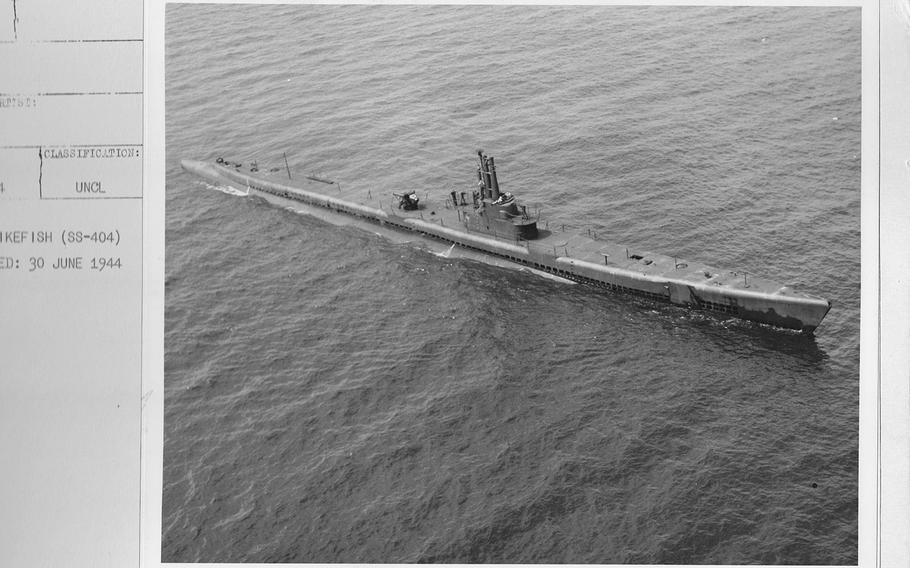
The USS Spikefish on its commissioning day, June 30, 1944, departs the Portsmouth, N.H., Navy yard. ()
GROTON, Conn. — J. "Deen" Brown's member number is 425.
Brown, 94, was among the first wave of men to join the national U.S. Submarine Veterans of World War II organization, doing so shortly after the war. After the national organization disbanded in 2012, a "splinter" organization was created, he said, because there was still an interest among members to keep it going.
But Brown and others always knew what happened Tuesday would be inevitable. That was the last official meeting of the eastern chapter of the organization, "but it's not our last social meeting," Brown said.
A small gathering — a sign of how few of these men are left — marked the occasion in a room checkered with Navy history at the U.S. Submarine Veterans clubhouse in Groton, Conn., Most of the men wore dark blue vests decorated with various emblems marking their service.
"I'm sorry I have to be the guy that turns the lights off," said chapter President Ed Childs, whose vest had his nickname "Easy Ed" embroidered on it.
"Not going there," Childs responded when asked how he got the nickname.
Across the table, Fred Stafford chuckled, saying "He won't tell anyone."
Declining membership shuttered the national organization and was also the reason the local chapter disbanded this week. World War II veterans are dying at a rapid rate, and those still alive are in their 90s. Many of them are in poor health.
The local chapter "has kept us together over the years," said Tony Faella, who drove down from Kingston, R.I., to attend the luncheon.
"Otherwise we would've all gone our separate ways," Faella said.
The Department of Veterans Affairs estimates about 430 World War II vets die each day. Ten years ago, there were more than 400 World War II submariners in Connecticut, Brown said. But now, he estimates there are fewer than 80.
"Too many, too fast," Childs said of his fellow World War II submariners who have died in recent years.
Over brisket, while sipping coffee out of yellow mugs with the words "U.S. Submarine Veterans Holland Club," and in some cases pint glasses of beer, the men swapped stories of their service.
There was a consensus that one of the more unwelcome smells on a submarine was that of lamb cooking. Lamb was abundant in Australia during the war, when there was a rule that U.S. ships leaving the country had to take a certain percentage of lamb meat with them.
"When we got underway we'd take all of the lamb out of the refrigerator and throw it overboard," Brown said. "We had the fattest sharks in Australia."
The men present Tuesday have more than 100 years of service among them.
Tuesday's luncheon was also about thanking the women who have supported the men through the years, and "especially for putting up with us," Brown said.
His wife, Lois Brown, 91, recalled a particularly hairy 12 hours more than 50 years ago. Around noontime, she received a phone call from the wife of a friend who said the USS Spikefish, to which her husband was assigned, had sunk.
"That was quite a scare," she said. "Three children and the Spikefish is down."
The submarine had lost all of its buoyancy, but the crew managed to recover. But Lois Brown didn't find that out until her husband called later, at midnight.
Her husband never talked much about the war, she said. "He never got out of World War II," she added.
"A lot of vets kept quiet after the war," Faella said.
About seven or eight years ago, Faella's grandchildren told him, "All right, Grandpa, give it up." They sat him down in the family cabin and questioned him about his time in the Navy. It was the first time Faella really opened up about his service, he said.
On Thursday, the Naval Submarine Base honored the men with a "sundowning" ceremony, marking the retirement of the group.
When the curtain opened at the Dealey Center Theater to reveal the men sitting on stage, a massive American flag hanging behind them, not one person in the audience stayed in their seats. Cheers were heard for several minutes before the official remarks began.
Capt. Paul Whitescarver, commanding officer of the base, and Capt. Aaron Thieme, commanding officer of the Naval Submarine School, in their remarks noted the sacrifices made by submariners during World War II. They suffered the highest number of casualties in the war of all the U.S. Armed Forces. Fifty-two submarines and more than 3,500 men were lost, Whitescarver said.
Those lost are immortalized in the U.S. Submarine Veterans of World War II memorial in Groton, which the organization has maintained. In many cases, where the submarines sank remains unknown, so the memorial serves as a final resting place for a lot of the families, Childs said.
"They can literally put their hands on their (loved ones') name," he said.
At the ceremony Thursday, the bios of Brown, Faella, Leroy Webb, Nicholas Calderiso (who was not present), William Scarano, Warren Wildes and Ron Williams were read. Several of the men completed multiple war patrols, like Scarano, of Groton, who completed six and whose submarine the USS Sealion (SS-315) rescued 54 prisoners of war. One of the men, Webb served on 17 different submarines during his 33½ years in the Navy.
———
©2016 The Day (New London, Conn.) Visit The Day (New London, Conn.) at www.theday.com Distributed by Tribune Content Agency, LLC.